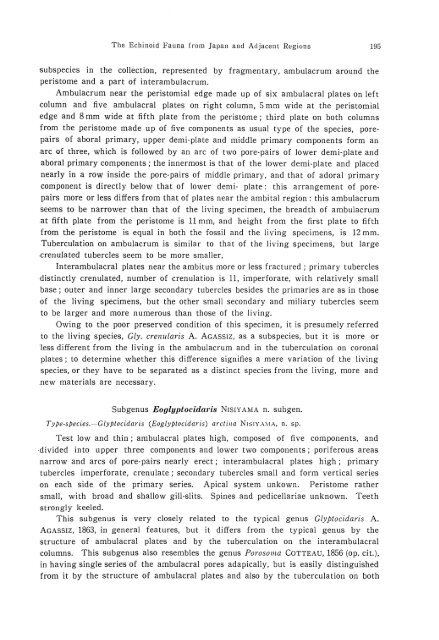the echinoid fauna from japan and adjacent regions part i
the echinoid fauna from japan and adjacent regions part i
the echinoid fauna from japan and adjacent regions part i
Create successful ePaper yourself
Turn your PDF publications into a flip-book with our unique Google optimized e-Paper software.
The Echinoid Fauna <strong>from</strong> Japan <strong>and</strong> Adjacent Regions 195<br />
subspecies in <strong>the</strong> collection, represented by fragmentary, ambulacrum around <strong>the</strong><br />
peristome <strong>and</strong> a <strong>part</strong> of interambulacrum.<br />
Ambulacrum near <strong>the</strong> peristomial edge made up of six ambulacral plates on left<br />
·column <strong>and</strong> five ambulacral plates on right column, 5 mm wide at <strong>the</strong> peristomial<br />
edge <strong>and</strong> 8 mm wide at fifth plate <strong>from</strong> <strong>the</strong> peristome; third plate on both columns<br />
<strong>from</strong> <strong>the</strong> peristome made up of five components as usual type of <strong>the</strong> species, porepairs<br />
of aboral primary, upper demi-plate <strong>and</strong> middle primary components form an<br />
.arc of three, which is followed by an arc of two pore-pairs of lower demi-plate <strong>and</strong><br />
aboral primary components; <strong>the</strong> innermost is that of <strong>the</strong> lower demi-plate <strong>and</strong> placed<br />
nearly in a row inside <strong>the</strong> pore-pairs of middle primary, <strong>and</strong> that of adoral primary<br />
component is directly below that of lower demi- plate: this arrangement of porepairs<br />
more or less differs <strong>from</strong> that of plates near <strong>the</strong> ambital region: this ambulacrum<br />
seems to be narrower than that of <strong>the</strong> living specimen, <strong>the</strong> breadth of ambulacrum<br />
at fifth plate <strong>from</strong> <strong>the</strong> peristome is 11 mm, <strong>and</strong> height <strong>from</strong> <strong>the</strong> first plate to fifth<br />
<strong>from</strong> <strong>the</strong> peristome is equal in both <strong>the</strong> fossil <strong>and</strong> <strong>the</strong> living specimens, is 12 mm.<br />
Tuberculation on ambulacrum is similar to that of <strong>the</strong> living specimens, but large<br />
·crenulated tubercles seem to be more smaller,<br />
Interambulacral plates near <strong>the</strong> ambitus more or less fractured; primary tubercles<br />
distinctly crenulated, number of crenulation is 11, imperforate, with relatively small<br />
base; outer <strong>and</strong> inner large secondary tubercles besides <strong>the</strong> primaries are as in those<br />
of <strong>the</strong> living specimens, but <strong>the</strong> o<strong>the</strong>r small secondary <strong>and</strong> miliary tubercles seem<br />
to be larger <strong>and</strong> more numerous than those of <strong>the</strong> living.<br />
Owing to <strong>the</strong> poor preserved condition of this specimen, it is presumely referred<br />
to <strong>the</strong> living species, Gly. crenularis A. AGASSIZ, as a subspecies, but it is more or<br />
less different <strong>from</strong> <strong>the</strong> living in <strong>the</strong> ambulacrum <strong>and</strong> in <strong>the</strong> tuberculation on coronal<br />
plates; to determine whe<strong>the</strong>r this difference signifies a mere variation of <strong>the</strong> living<br />
species, or <strong>the</strong>y have to be separated as a distinct species <strong>from</strong> <strong>the</strong> living, more <strong>and</strong><br />
.new materials are necessary.<br />
Subgenus Eoglyptocidnris NISIY AMA n. subgen.<br />
Type-species.-Glyptocidaris (Eoglyptocidaris) arctina NlSIYAMA, n. sp.<br />
Test low <strong>and</strong> thin; ambulacral plates high, composed of five components, <strong>and</strong><br />
·divided into upper three components <strong>and</strong> lower two components; poriferous areas<br />
narrow <strong>and</strong> arcs of pore-pairs nearly erect; interambulacral plates high; primary<br />
tubercles imperforate, crenulate; secondary tubercles small <strong>and</strong> form vertical series<br />
on each side of <strong>the</strong> primary series. Apical system unkown. Peristome ra<strong>the</strong>r<br />
small, with broad <strong>and</strong> shallow gill-slits. Spines <strong>and</strong> pedicellariae unknown. Teeth<br />
strongly keeled.<br />
This subgenus is very closely related to <strong>the</strong> typical genus Glyptocidaris A.<br />
AGASSIZ, 1863, in general features, but it differs <strong>from</strong> <strong>the</strong> typical genus by <strong>the</strong><br />
structure of ambulacral plates <strong>and</strong> by <strong>the</strong> tuberculation on <strong>the</strong> interambulacral<br />
columns. This subgenus also resembles <strong>the</strong> genus Porosoma COTTEAU, 1856 (op. cit.),<br />
in having single series of <strong>the</strong> ambulacral pores adapically, but is easily distinguished<br />
<strong>from</strong> it by <strong>the</strong> structure of ambulacral plates <strong>and</strong> also by <strong>the</strong> tuberculation on both












